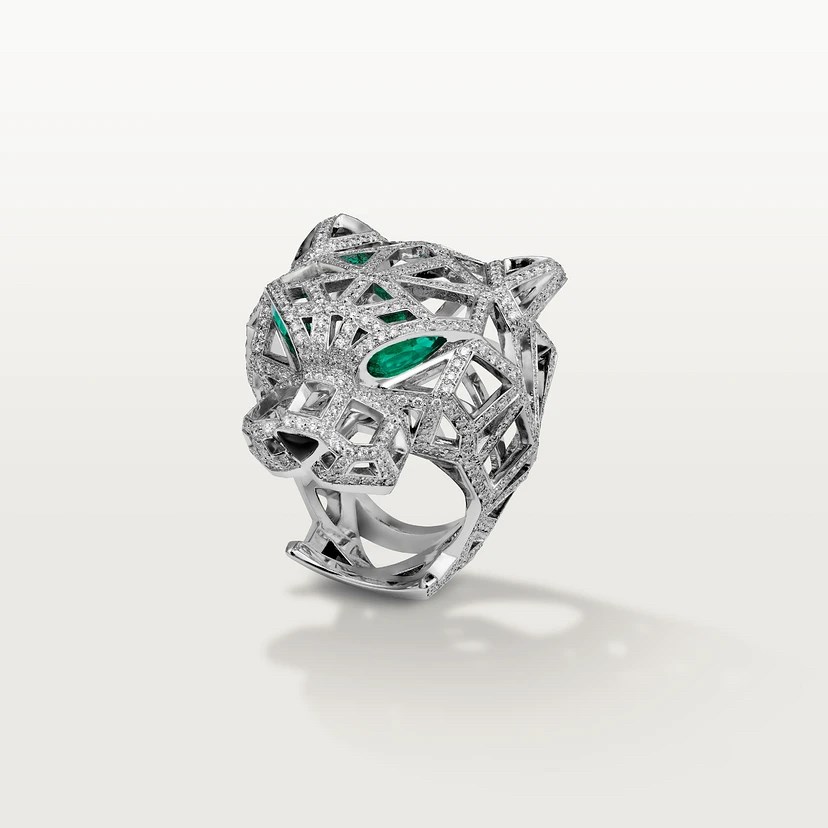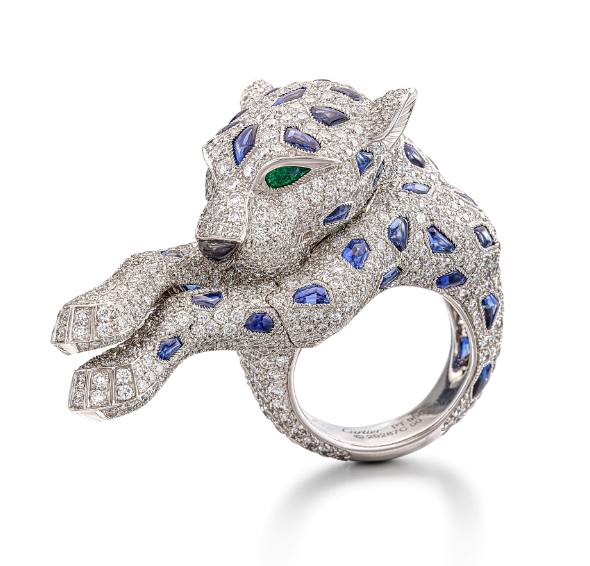Cartier’s Iconic Cat
05 October 2023
Share
Why the panther reigns supreme at the French jewellery maison
By Kim Parker
Of all the creatures in Cartier’s sparkling bestiary, the panther is irrefutably king. Or perhaps that should be queen because the great cat’s near-mythic status at the house is largely due to one enigmatic and fascinating woman: Jeanne Toussaint.
Toussaint, who worked at Cartier as creative director of jewellery between 1933 and 1970, was nicknamed ‘the panther’ for her fierce determination and is credited with elevating the feline into an iconic design during her tenure. Little is actually known about her past. Born in 1887 to a lace-making family in Belgium, she left home at 13 to seek her fortune in Paris as a model. Years later, as a member of the city’s vibrant pre-war ‘café society’, she rubbed shoulders with the likes of Gabrielle Chanel, Cecil Beaton and Louis Cartier – grandson of Cartier founder Louis-François, and the man who would go on to become her lover.
Keen to make use of Toussaint’s exquisite personal taste at his family firm, Cartier recruited her to oversee accessories – namely women’s handbags – in the early 1920s, before promoting her to the head of his new silver department in 1924, where she also worked on Cartier’s more accessible jewellery collections. Unable to sketch herself, Toussaint nevertheless possessed the exacting eye and natural flair of an artist and was eventually appointed creative director in 1933. One of the first women to occupy such a prominent role within the industry, she oversaw an all-male staff of gem-setters and artisan jewellers at Cartier’s Rue de la Paix studio. It was here that she began working closely with in-house designer, Peter Lemarchand, a frequent visitor to Paris’ Bois de Vincennes Zoo, to craft what would become the brand’s most evocative creature in all its lissom beauty.

Panthère de Cartier ring, white gold, diamond, emerald, onyx
Available at Cartier
Prior to Toussaint’s entrance into the glittering world of Cartier, great cats were already a pervasive presence in early 20th century Western art, thanks to a growing fascination with African and Asian cultures in which the big cats had long been associated with royalty, protection and power. After Tutankhamun’s tomb was uncovered in 1922, for example, Egyptomania gripped the fashionable echelons of society, sparking a vogue for trinkets featuring the panther-headed goddess Bastet and the feline-bodied sphinx. This was also an era when the revered American interior designer Elsie de Wolfe revitalised 18th century footstools by covering them in leopard pelts, and entertainers such as Josephine Baker and Sarah Bernhardt showed off their pet cheetahs – living symbols of their irrepressible joie de vivre.
 Panthère de Cartier bracelet in platinum
Panthère de Cartier bracelet in platinum
Available at Cartier
By this time, the panther had already made a tentative appearance at Cartier. In 1914, its coat was the inspiration for an abstract pattern of white diamonds and onyx spots on a dainty bracelet watch. That same year, Louis Cartier commissioned the celebrated illustrator George Barbier to create a display card for a new jewellery collection. The resulting artwork, Dame à la Panthère, depicted an elegant woman in a white gown and ropes of luminous pearls, with a black panther at her feet. The model for this portrait, it is said, was Barbier’s friend, Jeanne Toussaint. Three years later, Louis Cartier gifted his paramour an onyx vanity case with one of its first figurative depictions of a panther pacing between two emerald-studded cypress trees.
In the years that followed, Toussaint and Peter Lemarchand evolved Cartier’s big cat away from stylised depictions like the one on her vanity case and began crafting them in 3D form using gold and precious stones. In 1948, the Duke of Windsor commissioned one such beast as a gift for his Duchess, and Toussaint duly delivered a roaring diamond panther atop a 116-carat emerald cabochon brooch – changing the fortunes of both the emblematic creature and Cartier forever. Indeed, so delighted was the Duchess, then considered one of the most stylish women in the world, that another panther was purchased a year later, this time poised on a 152.35-carat polished sapphire. A pride of chic women duly followed suit and commissioned their own daring panther designs, including the fashionable heiress Daisy Fellowes, the socialite Nina Dyer, who was married to Prince Sadruddin Aga Khan, and the renowned Latin-American actress Maria Félix.

'Panthère' Diamond, Sapphire, Emerald and Onyx Ring by Cartier
Available at Sotheby's
Over the decades, Cartier’s panther has padded its way across a range of fine jewels, as well as handbags, sunglasses and, in the mid-1980s, even a floral fragrance. Its latest incarnation is as a precious high jewellery motif in Cartier’s Le Voyage Recommence collection, which launched this summer. Here, a spotted diamond and onyx cat with emerald eyes can be seen crouching on a spectacular necklace, as if keeping watch over a clutch of three spectacular aquamarines weighing a total of 20.33 carats. Ferocious, feminine and every bit as fascinating as when it first appeared at the maison, Cartier’s infamous cat stalks on and will do for many years to come.
By Kim Parker
Of all the creatures in Cartier’s sparkling bestiary, the panther is irrefutably king. Or perhaps that should be queen because the great cat’s near-mythic status at the house is largely due to one enigmatic and fascinating woman: Jeanne Toussaint.
Toussaint, who worked at Cartier as creative director of jewellery between 1933 and 1970, was nicknamed ‘the panther’ for her fierce determination and is credited with elevating the feline into an iconic design during her tenure. Little is actually known about her past. Born in 1887 to a lace-making family in Belgium, she left home at 13 to seek her fortune in Paris as a model. Years later, as a member of the city’s vibrant pre-war ‘café society’, she rubbed shoulders with the likes of Gabrielle Chanel, Cecil Beaton and Louis Cartier – grandson of Cartier founder Louis-François, and the man who would go on to become her lover.
Keen to make use of Toussaint’s exquisite personal taste at his family firm, Cartier recruited her to oversee accessories – namely women’s handbags – in the early 1920s, before promoting her to the head of his new silver department in 1924, where she also worked on Cartier’s more accessible jewellery collections. Unable to sketch herself, Toussaint nevertheless possessed the exacting eye and natural flair of an artist and was eventually appointed creative director in 1933. One of the first women to occupy such a prominent role within the industry, she oversaw an all-male staff of gem-setters and artisan jewellers at Cartier’s Rue de la Paix studio. It was here that she began working closely with in-house designer, Peter Lemarchand, a frequent visitor to Paris’ Bois de Vincennes Zoo, to craft what would become the brand’s most evocative creature in all its lissom beauty.

Panthère de Cartier ring, white gold, diamond, emerald, onyx
Available at Cartier
Prior to Toussaint’s entrance into the glittering world of Cartier, great cats were already a pervasive presence in early 20th century Western art, thanks to a growing fascination with African and Asian cultures in which the big cats had long been associated with royalty, protection and power. After Tutankhamun’s tomb was uncovered in 1922, for example, Egyptomania gripped the fashionable echelons of society, sparking a vogue for trinkets featuring the panther-headed goddess Bastet and the feline-bodied sphinx. This was also an era when the revered American interior designer Elsie de Wolfe revitalised 18th century footstools by covering them in leopard pelts, and entertainers such as Josephine Baker and Sarah Bernhardt showed off their pet cheetahs – living symbols of their irrepressible joie de vivre.
 Panthère de Cartier bracelet in platinum
Panthère de Cartier bracelet in platinumAvailable at Cartier
By this time, the panther had already made a tentative appearance at Cartier. In 1914, its coat was the inspiration for an abstract pattern of white diamonds and onyx spots on a dainty bracelet watch. That same year, Louis Cartier commissioned the celebrated illustrator George Barbier to create a display card for a new jewellery collection. The resulting artwork, Dame à la Panthère, depicted an elegant woman in a white gown and ropes of luminous pearls, with a black panther at her feet. The model for this portrait, it is said, was Barbier’s friend, Jeanne Toussaint. Three years later, Louis Cartier gifted his paramour an onyx vanity case with one of its first figurative depictions of a panther pacing between two emerald-studded cypress trees.
In the years that followed, Toussaint and Peter Lemarchand evolved Cartier’s big cat away from stylised depictions like the one on her vanity case and began crafting them in 3D form using gold and precious stones. In 1948, the Duke of Windsor commissioned one such beast as a gift for his Duchess, and Toussaint duly delivered a roaring diamond panther atop a 116-carat emerald cabochon brooch – changing the fortunes of both the emblematic creature and Cartier forever. Indeed, so delighted was the Duchess, then considered one of the most stylish women in the world, that another panther was purchased a year later, this time poised on a 152.35-carat polished sapphire. A pride of chic women duly followed suit and commissioned their own daring panther designs, including the fashionable heiress Daisy Fellowes, the socialite Nina Dyer, who was married to Prince Sadruddin Aga Khan, and the renowned Latin-American actress Maria Félix.

'Panthère' Diamond, Sapphire, Emerald and Onyx Ring by Cartier
Available at Sotheby's
Over the decades, Cartier’s panther has padded its way across a range of fine jewels, as well as handbags, sunglasses and, in the mid-1980s, even a floral fragrance. Its latest incarnation is as a precious high jewellery motif in Cartier’s Le Voyage Recommence collection, which launched this summer. Here, a spotted diamond and onyx cat with emerald eyes can be seen crouching on a spectacular necklace, as if keeping watch over a clutch of three spectacular aquamarines weighing a total of 20.33 carats. Ferocious, feminine and every bit as fascinating as when it first appeared at the maison, Cartier’s infamous cat stalks on and will do for many years to come.
